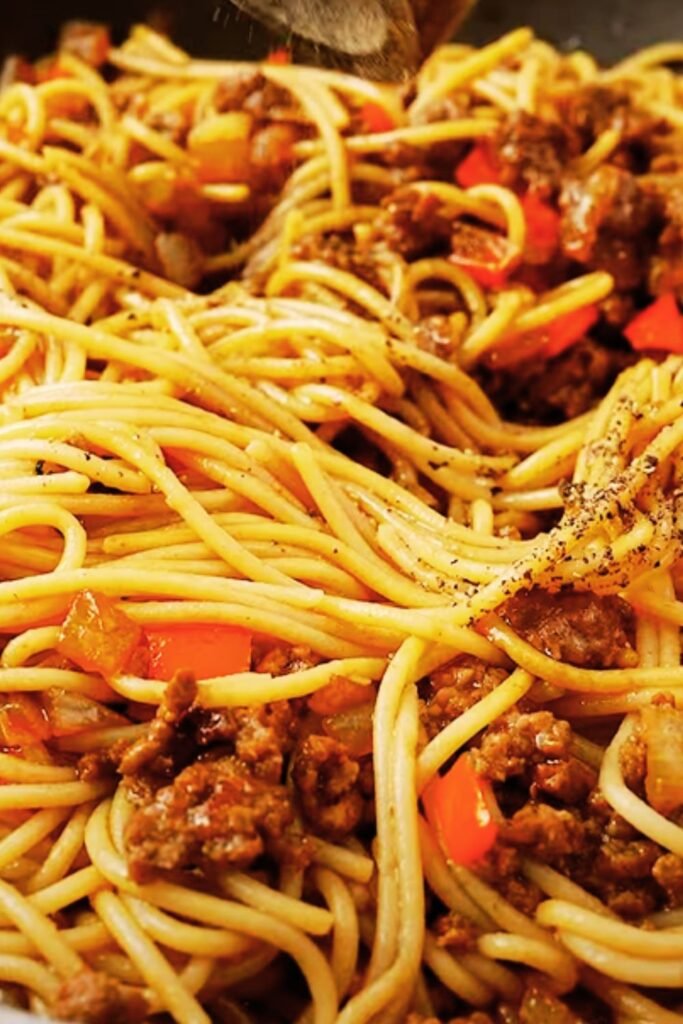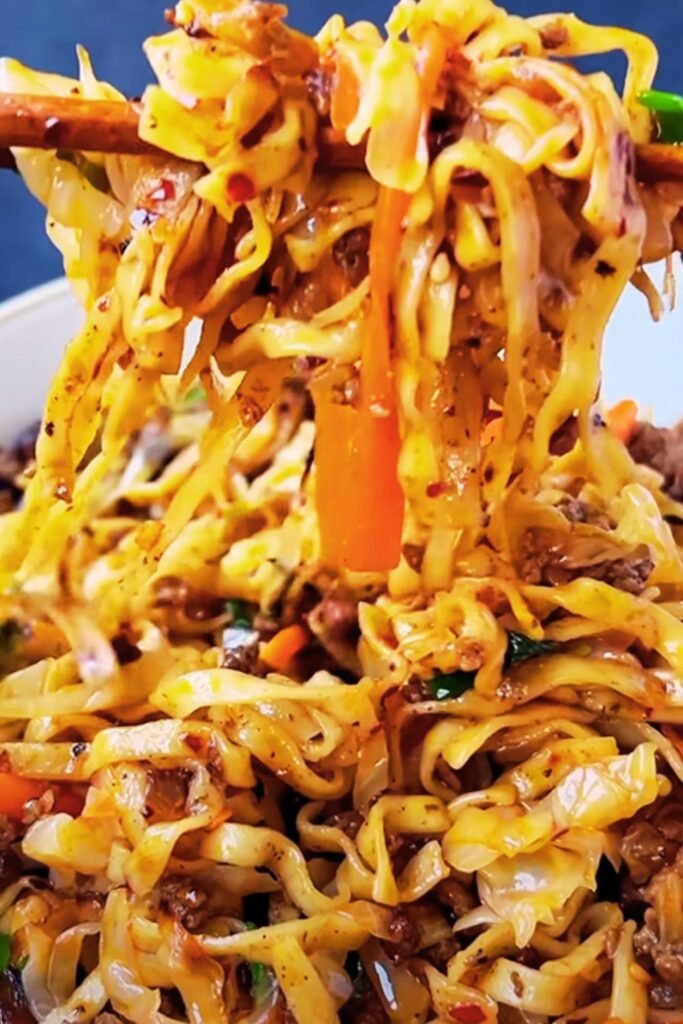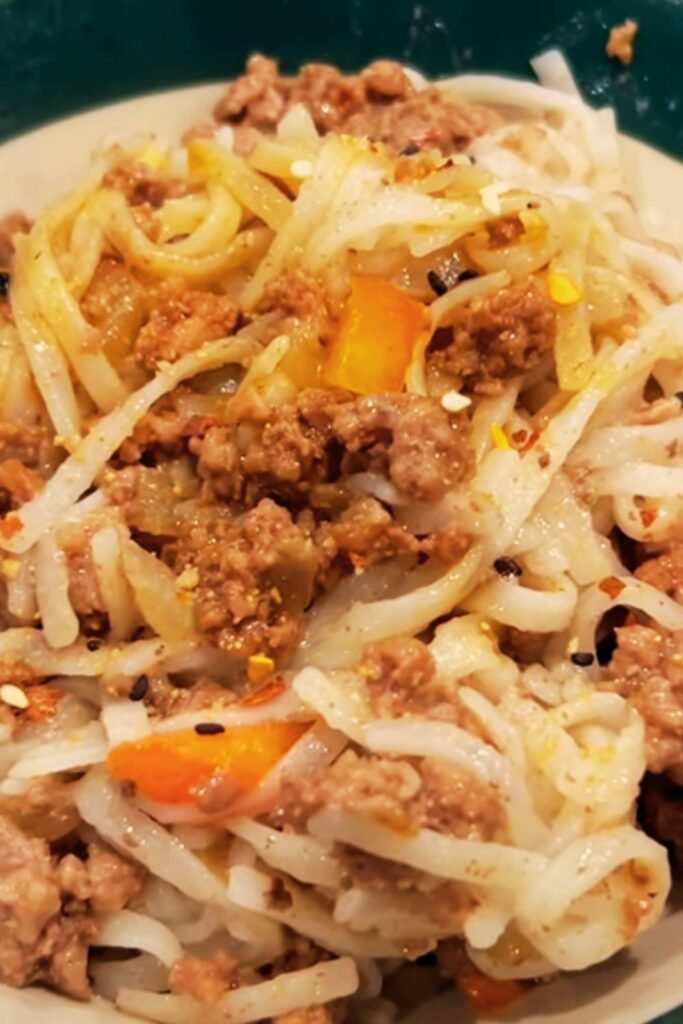There’s something magical about the combination of tender ground beef, springy noodles, and savory Asian sauces that makes my taste buds dance with joy. As someone who’s spent years perfecting quick weeknight dinners that don’t sacrifice flavor, I can confidently say that Asian Ground Beef Noodles has earned its permanent spot in my recipe rotation. This dish brings together the rich umami of soy sauce, the subtle sweetness of hoisin, the aromatic warmth of ginger and garlic, all clinging beautifully to perfectly cooked noodles and protein-packed ground beef.
What I love most about this recipe is its incredible versatility. Whether you’re cooking for picky eaters, need to clean out your vegetable drawer, or simply crave something comforting yet exciting, this dish delivers every single time. In just about 30 minutes from start to finish, you can have a restaurant-quality meal that will leave everyone asking for seconds.
Why You’ll Love This Recipe
I still remember the first time I made this dish. It was one of those hectic weeknights when the clock was ticking, hungry family members were circling the kitchen, and I needed something fast that wasn’t another takeout order. This Asian ground beef noodle stir-fry saved the day, and it’s been a lifesaver countless times since then.
Here’s why this recipe deserves a special place in your cooking arsenal:
- Quick and efficient: Ready in just 30 minutes with minimal cleanup
- Budget-friendly: Uses economical ground beef instead of pricier cuts
- Incredibly versatile: Adaptable to whatever vegetables you have on hand
- Balanced meal: Protein, vegetables, and carbs all in one delicious dish
- Meal-prep friendly: Stores and reheats beautifully for lunches
- Kid-approved: The familiar noodles and mild (customizable) flavors appeal to younger palates
- Flavor-packed: The sauce creates deep, complex flavors with simple ingredients
Key Ingredients

For the Noodles and Beef:
| Ingredient | Amount | Notes |
|---|---|---|
| Ground beef | 1 pound (450g) | 80-85% lean works best for flavor |
| Noodles | 8 oz (225g) | Lo mein, ramen, or rice noodles |
| Neutral oil | 2 tablespoons | Canola, vegetable, or avocado oil |
| Garlic | 4 cloves, minced | Fresh provides the best flavor |
| Ginger | 1 tablespoon, grated | Use fresh for brightest flavor |
| Onion | 1 medium, thinly sliced | Yellow or white onion |
| Bell peppers | 1-2, sliced | Any color works well |
| Carrots | 2 medium, julienned | Adds sweetness and crunch |
| Green onions | 4-5 stalks, sliced | Reserve some for garnish |
| Sesame seeds | 1 tablespoon | For garnish |
For the Sauce:
| Sauce Ingredient | Amount | Function in Dish |
|---|---|---|
| Soy sauce | 1/4 cup | Provides salty depth and umami |
| Hoisin sauce | 2 tablespoons | Adds sweetness and complexity |
| Oyster sauce | 1 tablespoon | Creates rich umami backbone |
| Rice vinegar | 1 tablespoon | Adds brightness and acidity |
| Sesame oil | 2 teaspoons | Provides nutty aroma |
| Brown sugar | 1 tablespoon | Balances the saltiness |
| Sriracha or chili garlic sauce | 1-2 teaspoons | Adds customizable heat |
| Cornstarch | 1 teaspoon | Thickens the sauce |
| Water or broth | 1/4 cup | Creates perfect consistency |
Step-by-Step Instructions
Preparation Phase
- Prepare your noodles: Cook according to package directions, but subtract 1 minute from the cooking time (they’ll finish cooking in the sauce). Drain, rinse with cold water to stop cooking, and toss with a teaspoon of oil to prevent sticking.
- Make the sauce: In a bowl, whisk together soy sauce, hoisin sauce, oyster sauce, rice vinegar, sesame oil, brown sugar, sriracha, cornstarch, and water/broth until completely smooth. Set aside.
- Prepare your vegetables: Have all vegetables chopped and ready before you start cooking. This stir-fry moves quickly!
Cooking Process
- Brown the beef: Heat a large wok or skillet over medium-high heat. Add 1 tablespoon of oil, then add the ground beef. Break it up with a wooden spoon and cook until no longer pink, about 5-6 minutes. Season with a pinch of salt and pepper. Transfer to a plate, leaving behind any rendered fat.
- Sauté aromatics: In the same pan, add the remaining oil if needed. Add onions and cook for 1-2 minutes until they begin to soften. Add garlic and ginger, stirring constantly for 30 seconds until fragrant.
- Cook vegetables: Add bell peppers and carrots to the pan. Stir-fry for 3-4 minutes until vegetables are crisp-tender.
- Combine everything: Return the cooked beef to the pan. Pour in the sauce and stir to coat everything. Bring to a simmer and let it cook for 1 minute until it begins to thicken.
- Add noodles: Add the pre-cooked noodles to the pan. Using tongs, gently toss everything together until the noodles are well-coated with sauce and warmed through, about 2-3 minutes.
- Final touches: Stir in most of the green onions, reserving some for garnish.
Plating and Serving
Transfer the noodles to a serving platter or individual bowls. Garnish with remaining green onions and sprinkle with sesame seeds. For added color and freshness, you can add some cilantro leaves or a squeeze of lime juice over the top.
Recipe Variations
One of the reasons I make this dish so often is because it’s incredibly adaptable. Here are some of my favorite variations:
Protein Swaps
| Protein Option | Cooking Adjustment | Flavor Profile |
|---|---|---|
| Ground pork | Cook exactly like beef | Slightly sweeter, works wonderfully with the Asian flavors |
| Ground chicken or turkey | Add extra 1 tbsp oil when cooking | Lighter flavor, great for those limiting red meat |
| Tofu (firm, crumbled) | Press first, cook longer to crisp | Vegetarian option that absorbs flavors well |
| Shrimp | Cook separately, add at end | Sweet seafood twist, cooks in just 2-3 minutes |
Vegetable Variations
The beauty of this recipe is that you can use almost any vegetables you have on hand:
- Mushrooms: Add wonderful umami depth
- Snow peas or sugar snap peas: Add delightful crunch
- Broccoli: Cut into small florets and blanch first
- Baby bok choy: Adds freshness and slight bitterness
- Bean sprouts: Add at the very end for crunch
- Cabbage: Thinly sliced, adds bulk and natural sweetness
Noodle Options

While I often use lo mein noodles, you can experiment with different noodle types:
| Noodle Type | Characteristics | Best For |
|---|---|---|
| Lo mein | Yellow, wheat-based, slightly chewy | Traditional flavor, holds sauce well |
| Ramen | Curly, wheat noodles | Lighter texture, absorbs flavors excellently |
| Rice noodles | White, gluten-free, delicate | Gluten-free option, lighter finish |
| Soba | Buckwheat noodles, earthy flavor | Nuttier flavor profile, adds nutritional value |
| Udon | Thick, chewy wheat noodles | Heartier dish with substantial bite |
| Spaghetti | Italian pasta, firm texture | Easy substitute when Asian noodles unavailable |
Sauce Adjustments
The sauce is incredibly forgiving and can be adjusted to your preference:
- Spicier version: Add more sriracha, chili oil, or crushed red pepper flakes
- Sweeter profile: Increase brown sugar or add a tablespoon of maple syrup
- Tangier twist: Add more rice vinegar or a squeeze of lime juice
- Extra umami: Add a tablespoon of miso paste or double the oyster sauce
- Herbaceous notes: Add Thai basil, cilantro, or mint at the end
Expert Tips for Perfect Asian Ground Beef Noodles
After making this dish countless times, I’ve discovered some techniques that take it from good to great:
- Don’t overcook the noodles: Keeping them slightly underdone before adding to the stir-fry prevents mushiness.
- High heat is your friend: A truly hot pan creates better flavor through caramelization and prevents vegetables from becoming soggy.
- Cook in batches if needed: Overcrowding the pan leads to steaming rather than stir-frying. If using a smaller pan, cook components separately.
- Mise en place is crucial: Have everything chopped, mixed, and ready before you start cooking. Once you begin, the process moves quickly.
- Season the meat properly: Don’t forget to add salt and pepper to the ground beef as it cooks, even though the sauce adds flavor later.
- Let the sauce simmer briefly: This activates the cornstarch and creates the perfect consistency to coat the noodles.
- Rest before serving: Letting the dish sit for 2-3 minutes after cooking allows the flavors to meld and the sauce to be absorbed.
Make-Ahead and Storage Information
| Storage Method | Instructions | Maximum Time |
|---|---|---|
| Refrigerator | Cool completely, store in airtight container | 3-4 days |
| Freezer | Portion into meal-prep containers | 2-3 months |
| Prep components ahead | Chop vegetables, mix sauce, store separately | 1-2 days before cooking |
When reheating, add a small splash of water or broth to refresh the sauce, and heat until just warm to avoid overcooking the noodles.
Serving Suggestions

While this dish is a complete meal on its own, I sometimes like to round it out with:
Side Options:
- Simple cucumber salad: Thinly sliced cucumbers dressed with rice vinegar, a pinch of sugar, and sesame seeds
- Miso soup: A light, umami-rich starter that complements the noodles perfectly
- Steamed edamame: Sprinkled with sea salt for a protein-rich appetizer
- Vegetable gyoza: Store-bought or homemade dumplings make a fantastic starter
- Pickled vegetables: Quick-pickled carrots and daikon add bright acidity
Beverage Pairings:
- Green tea: The slightly bitter notes contrast beautifully with the savory dish
- Jasmine tea: Floral notes complement the aromatic ingredients
- Sparkling water with lime: Refreshing and palate-cleansing
- Coconut water: Slightly sweet with electrolytes for balance
- Iced oolong tea: Complex flavor that stands up to the rich dish
Nutritional Benefits
This balanced one-pan meal offers numerous nutritional benefits:
| Component | Nutritional Benefit |
|---|---|
| Ground beef | High-quality protein, iron, zinc, and B vitamins |
| Vegetables | Fiber, vitamins A and C, antioxidants |
| Noodles | Carbohydrates for energy |
| Ginger | Anti-inflammatory properties, digestive benefits |
| Garlic | Immune-boosting compounds, heart health support |
| Sesame seeds | Calcium, magnesium, and healthy fats |
Common Mistakes to Avoid
Through my experience making this dish regularly, I’ve identified some common pitfalls:
- Using pre-ground ginger or garlic: The flavor difference with fresh is enormous.
- Not draining excess fat from beef: Too much fat can make the dish greasy and dilute the sauce.
- Overcooking the vegetables: They should maintain some crispness for textural contrast.
- Adding noodles without rinsing: This can lead to clumping and uneven sauce distribution.
- Using low-sodium soy sauce without adjusting: Regular soy sauce provides better flavor; if using low-sodium, you may need to add salt.
- Rushing the sauce thickening: Let it simmer properly to activate the cornstarch.
- Not tasting before serving: Always check if it needs more salt, acid, or sweetness.
Budget-Friendly Tips
This dish is already economical, but here are some ways to make it even more budget-friendly:
- Buy ground beef in bulk: Portion and freeze what you don’t need immediately
- Use seasonal vegetables: They’re cheaper and more flavorful
- Make your own noodles: With just flour and water, you can create simple hand-cut noodles
- Substitute ingredients: Regular white vinegar can replace rice vinegar, and brown sugar can replace more expensive sweeteners
- Extend with extra vegetables: Adding more vegetables stretches the meat further
- Use pantry staples: Soy sauce and other Asian condiments last a long time and can be used in many dishes
Frequently Asked Questions
Q: Can I make this dish gluten-free?
A: Absolutely! Use rice noodles instead of wheat-based ones, and make sure to use gluten-free versions of soy sauce, hoisin sauce, and oyster sauce. There are excellent gluten-free alternatives available in most grocery stores.
Q: I don’t have hoisin sauce. What can I substitute?
A: You can make a quick substitute by mixing 2 tablespoons of soy sauce with 1 tablespoon of peanut butter, 1 teaspoon of honey, a splash of vinegar, minced garlic, and a pinch of five-spice powder if you have it.
Q: How spicy is this recipe as written?
A: As written, it has a mild to medium heat level from the 1-2 teaspoons of sriracha. You can adjust this to your preference – omit completely for no heat or add more for extra spice. Adding the sriracha to individual portions at the table is another great option for families with varying spice preferences.
Q: Can I use frozen vegetables?
A: Yes! Frozen vegetables work well in this recipe. No need to thaw them first – just add them directly to the stir-fry and cook for an additional 1-2 minutes until heated through.
Q: What’s the best type of ground beef to use?
A: I recommend 80-85% lean ground beef for the best flavor and texture. If you use leaner beef (90% or higher), consider adding an extra tablespoon of oil to compensate for the reduced fat content.
Q: Can I make this ahead for meal prep?
A: This dish is perfect for meal prep! It keeps well in the refrigerator for 3-4 days. For best results when reheating, add a splash of water or broth and heat gently to prevent the noodles from drying out.
Q: My sauce didn’t thicken properly. What went wrong?
A: Make sure your cornstarch is fully dissolved in the liquid before adding it to the hot pan. Also, the sauce needs to come to a simmer to activate the cornstarch. If it’s still too thin, you can mix an additional teaspoon of cornstarch with a tablespoon of cold water and stir it in.
Q: What can I use instead of oyster sauce?
A: For a vegetarian alternative, use vegetarian stir-fry sauce or mushroom-based oyster sauce. In a pinch, you can substitute with additional hoisin sauce or soy sauce with a pinch of sugar.
A Note on Authenticity
While this dish draws inspiration from various Asian cuisines, it’s more of a fusion creation than a traditionally authentic recipe from any single country. I’ve developed it over years of experimenting with flavors I love, taking cues from Chinese lo mein, Japanese yakisoba, and Korean japchae. What matters most is that it’s delicious, adaptable, and brings joy to your table!
If you’re interested in exploring more authentic Asian noodle dishes, consider researching specific regional recipes like Taiwanese beef noodle soup, Japanese yaki udon, or Thai pad see ew.
Final Thoughts
In my kitchen, Asian Ground Beef Noodles has earned its place as a reliable, crave-worthy meal that never disappoints. What started as a simple weeknight solution has become a dish I genuinely look forward to making and eating. The combination of tender beef, crisp-tender vegetables, and sauce-slicked noodles creates a perfect bite every time.
I hope this recipe finds a place in your regular rotation too. Don’t be afraid to make it your own – swap proteins, experiment with vegetables, or adjust the sauce to suit your family’s preferences. The beauty of this dish lies in its adaptability and forgiving nature.
Remember, cooking should be joyful and relaxed. If you don’t have every ingredient listed, use what you have and trust your instincts. The best meals often come from creative substitutions and happy accidents!
I’d love to hear how this recipe works for you, what variations you’ve tried, and how you’ve made it your own. Happy cooking!